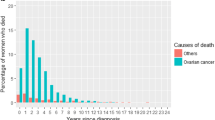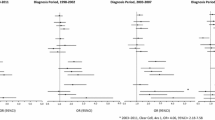Abstract
Objectives
Despite the lack of effective screening, almost 20% of women with ovarian cancer are diagnosed at an early stage of disease, when the prognosis is favorable. This study sought to elucidate tumor-related, census-based socioeconomic indicators, and demographic characteristics associated with early diagnosis of epithelial ovarian cancer (EOC).
Methods
The study population included 16,228 women diagnosed with epithelial ovarian cancer from 1996 through 2006 and reported to the California Cancer Registry. Women diagnosed with stage I tumors were compared to those diagnosed with stage III or IV disease with respect to several demographic and tumor-related characteristics. Logistic regression was used to estimate adjusted odds ratios (OR) and associated 95% confidence intervals.
Results
Age at diagnosis, tumor histology, tumor size, laterality, and grade were all strongly associated with EOC early stage at diagnosis. However, after adjusting for all relevant factors in this study, other disparities were detected. Compared with white women, the likelihood of being diagnosed with early-stage disease was significantly lower among African Americans (OR = 0.78, 95% CI = 0.55–0.92), and significantly higher among women with private insurance compared to those either uninsured or covered by Medicaid (OR = 1.6, 95% CI = 1.18–2.05).
Conclusion
These findings suggest that, in addition to tumor biology, disparities in access to care may have a significant effect on the timely diagnosis of epithelial ovarian cancer.
Similar content being viewed by others
References
Ovarian Cancer Symptoms Consensus Statement: Gynecologic Cancer Foundation, Society of Gynecologic Oncologists, American Cancer Society; 2007
Ries Lag HD, Krapcho M, Mariotto A, Miller BA, Feuer EJ, Clegg L, Eisner MP, Horner MJ, Howlader N, Hayat M, Hankey BF, Edwards BK (2007) SEER cancer statistics review, 1975–2004. National Cancer Institute, Bethesda
Jacobs IJ, Shepherd JH, Oram DH, Blackett AD, Luesley DM, Berchuck A, Hudson CN (eds) (2002) Ovarian cancer, 2nd edn. Oxford University Press, Oxford
NAACCR Latino Research Work Group. NAACCR Guideline for Enhancing Hispanic/Latino Identification: Revised NAACCR Hispanic/Latino Identification Algorithm [NHIA v2]. Springfield, IL: North American Association of Central Cancer Registries September 2005
Liu L, Deapen D, Bernstein L (1998) Socioeconomic status and cancers of the female breast and reproductive organs: a comparison across racial/ethnic populations in Los Angeles County, California (United States). Cancer Causes Control 9:369–380
Yost K, Perkins C, Cohen R, Morris C, Wright W (2001) Socioeconomic status and breast cancer incidence in California for different race/ethnic groups. Cancer Causes Control 12:703–711
SEER Program: Comparative Staging Guide for Cancer, Version 1.1: National Cancer Institute, National Institutes of Health Publication Publication No. 93-3640 June, 1993
Goodman MT, Howe HL (2007) Descriptive epidemiology of ovarian cancer in the United States, 1992–1997. Cancer 97:2615–2630
Lataifeh I, Marsden DE, Robertson G, Gebski V, Hacker NF (2005) Presenting symptoms of epithelial ovarian cancer. Aust NZ J Obstet Gynaecol 45:211–214
Goodman MT, Correa CN, Tung KH et al (2003) Stage at diagnosis of ovarian cancer in the United States, 1992–1997. Cancer 97:2648–2659
Ozols RF, Rubin SC, Thomas G, Robboy S (1997) Epithelial ovarian cancer. In: Hoskins WJ, Perez CA, Young RC (eds) Principles and practice of gynecologic oncology, 2nd edn. Lippincott-Raven, Philadelphia
Wikborn C, Pettersson F, Moberg PJ (1996) Delay in diagnosis of epithelial ovarian cancer. Int J Gynaecol Obstet 52:263–267
Vercellini P, Parazzini F, Bolis G et al (1993) Endometriosis and ovarian cancer. Am J Obstet Gynecol 169:181–182
Somigliana E, Vigano P, Parazzini F, Stoppelli S, Giambattista E, Vercellini P (2006) Association between endometriosis and cancer: a comprehensive review and a critical analysis of clinical and epidemiological evidence. Gynecol Oncol 101:331–341
Fukunaga M, Nomura K, Ishikawa E, Ushigome S (1997) Ovarian atypical endometriosis: its close association with malignant epithelial tumours. Histopathology 30:249–255
Ogawa S, Kaku T, Amada S et al (2000) Ovarian endometriosis associated with ovarian carcinoma: a clinicopathological and immunohistochemical study. Gynecol Oncol 77:298–304
Sainz de la Cuesta R, Eichhorn JH, Rice LW, Fuller AF Jr, Nikrui N, Goff BA (1996) Histologic transformation of benign endometriosis to early epithelial ovarian cancer. Gynecol Oncol 60:238–244
Brinton LA, Gridley G, Persson I, Baron J, Bergqvist A (1997) Cancer risk after a hospital discharge diagnosis of endometriosis. Am J Obstet Gynecol 176:572–579
Borgfeldt C, Andolf E (2004) Cancer risk after hospital discharge diagnosis of benign ovarian cysts and endometriosis. Acta Obstet Gynecol Scand 83:395–400
Oral E, Ilvan S, Tustas E et al (2003) Prevalence of endometriosis in malignant epithelial ovary tumours. Eur J Obstet Gynecol Reprod Biol 109:97–101
McMeekin DS, Burger RA, Manetta A, DiSaia P, Berman ML (1995) Endometrioid adenocarcinoma of the ovary and its relationship to endometriosis. Gynecol Oncol 59:81–86
Erzen M, Rakar S, Klancnik B, Syrjanen K (2001) Endometriosis-associated ovarian carcinoma (EAOC): an entity distinct from other ovarian carcinomas as suggested by a nested case-control study. Gynecol Oncol 83:100–108
Russell SE, McCluggage WG (2004) A multistep model for ovarian tumorigenesis: the value of mutation analysis in the KRAS and BRAF genes. J Pathol 203:617–619
Berchuck A, Iversen ES, Luo J et al (2009) Microarray analysis of early stage serous ovarian cancers shows profiles predictive of favorable outcome. Clin Cancer Res 15:2448–2455
Shih Ie M, Kurman RJ (2004) Ovarian tumorigenesis: a proposed model based on morphological and molecular genetic analysis. Am J Pathol 164:1511–1518
Kurman RJ, Visvanathan K, Roden R, Wu TC, Shih Ie M (2008) Early detection and treatment of ovarian cancer: shifting from early stage to minimal volume of disease based on a new model of carcinogenesis. Am J Obstet Gynecol 198:351–356
Ayanian JZ, Weissman JS, Schneider EC, Ginsburg JA, Zaslavsky AM (2000) Unmet health needs of uninsured adults in the United States. JAMA 284:2061–2069
Ioannou GN, Chapko MK, Dominitz JA (2003) Predictors of colorectal cancer screening participation in the United States. Am J Gastroenterol 98:2082–2091
Potosky AL, Breen N, Graubard BI, Parsons PE (1998) The association between health care coverage, the use of cancer screening tests. Results from the 1992 National Health Interview Survey. Med Care 36:257–270
Berk ML, Schur CL (1998) Access to care: how much difference does Medicaid make? Health Aff (Millwood) 17:169–180
Schoen C, DesRoches C (2000) Uninsured and unstably insured: the importance of continuous insurance coverage. Health Serv Res 35:187–206
Halpern MT, Ward EM, Pavluck AL, Schrag NM, Bian J, Chen AY (2008) Association of insurance status and ethnicity with cancer stage at diagnosis for 12 cancer sites: a retrospective analysis. Lancet Oncol 9:222–231
Keating NL, Landrum MB, Ayanian JZ, Winer EP, Guadagnoli E (2005) The association of ambulatory care with breast cancer stage at diagnosis among Medicare beneficiaries. J Gen Intern Med 20:38–44
Roetzheim RG, Pal N, Tennant C et al (1999) Effects of health insurance and race on early detection of cancer. J Natl Cancer Inst 91:1409–1415
Bradley CJ, Given CW, Roberts C (2003) Late stage cancers in a Medicaid-insured population. Med Care 41:722–728
Reid BC, Rozier RG (2006) Continuity of care and early diagnosis of head and neck cancer. Oral Oncol 42:510–516
Kirsner RS, Wilkinson JD, Ma F, Pacheco H, Federman DG (2005) The association of Medicare health care delivery systems with stage at diagnosis and survival for patients with melanoma. Arch Dermatol 141:753–757
Agency for Healthcare Research and Quality (2007) National Healthcare Disparities Report. Rockville, MD: U.S. Department of Health and Human Services, Agency for Healthcare Research and Quality; February 2008. AHRQ Pub. No. 08-0041
Forstner R (2007) Radiological staging of ovarian cancer: imaging findings and contribution of CT and MRI. Eur Radiol 17:3223–3235
Carney ME, Lancaster JM, Ford C, Tsodikov A, Wiggins CL (2002) A population-based study of patterns of care for ovarian cancer: who is seen by a gynecologic oncologist and who is not? Gynecol Oncol 84:36–42
Chan JK, Gomez SL, O’Malley CD, Perkins CI, Clarke CA (2006) Validity of cancer registry medicaid status against enrollment files: implications for population-based studies of cancer outcomes. Med Care 44:952–955
Acknowledgments
The California Cancer Registry (CCR) is a collaborative effort between the California Department of Public Health (CDPH) and the Public Health Institute (PHI). The collection of cancer incidence data used in this study was supported by the CDPH as part of the statewide cancer reporting program mandated by the California Health and Safety Code Section 103885; the National Cancer Institute’s (NCI) Surveillance, Epidemiology, and End Results (SEER) Program under contract N01-PC-35136 awarded to the Northern California Cancer Center, contract N01-PC-35139 awarded to the University of Southern California, and contract N01-PC-54404 awarded to PHI; and the Centers for Disease Control and Prevention’s (CDC) National Program of Cancer Registries, under agreement No. 1U58DP00807-01 awarded to PHI. The ideas and opinions expressed herein are those of the author(s), and endorsement by CDPH, NCI, and CDC or their contractors and subcontractors is not intended nor should be inferred.
Author information
Authors and Affiliations
Corresponding author
Rights and permissions
About this article
Cite this article
Morris, C.R., Sands, M.T. & Smith, L.H. Ovarian cancer: predictors of early-stage diagnosis. Cancer Causes Control 21, 1203–1211 (2010). https://doi.org/10.1007/s10552-010-9547-0
Received:
Accepted:
Published:
Issue Date:
DOI: https://doi.org/10.1007/s10552-010-9547-0




